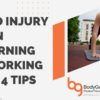By: Dr. Lauren Mallari, PT, DPT, Women’s Health Specialist
You’ve got this tiny, shiny, new babe in your arms; you are their everything and they are yours. You are a main source of life for them, which is so awesome and a bond that cannot be broken! That is why it is so important to discover the most efficient and comfortable nursing positions that will keep you connected with your baby, without the pesky and painful interruptions of neck, shoulder or back pain. Despite the fact that your baby is so tiny and relatively light, after long periods of time and/or frequent bouts of nursing, significant stress can be put on these body parts. This stress is likely related to your body position opposed to the weight of your newborn. Plus, the cuteness of your little one can be distracting leaving you with seemingly unrelated aches and pains later! Here at Body Gears, we want to help you thoroughly enjoy the gift of nursing without the added aches and pains. Below you will find two great tips that are easily applied and can change your nursing habits!
Tip #1: Make that Boppy or pillow/s work FOR you!
Not just work with you, but work FOR you. Of course you will be cradling and cuddling your baby while nursing, but there is no reason why you can’t be cuddled and supported too! One major inefficiency seen is breast feeding mothers spending excessive time setting up with the Boppy or pillow under their arms and breasts, but then not ACTUALLY USE IT. Instead of allowing your shoulders to shrug up, stack your pillows higher than you’d expect, then plop your baby holding arms right on top and let your shoulders and arms REST. You can still move your hands and arms to assist with latching, but then try your hardest to relax your upper body. The weight of your arms + baby will compress the pillows or Boppy down to a more manageable size and give you actual support and not just fluff. This also helps to raise baby higher so you no longer need to prop up on your very tippy toes or slump down to bring your breast down to baby. Just bring baby and Boppy UP to you!
Tip #2: Sit On your Pelvic Floor
While nursing, you may be spending a lot of time sitting, so it is imperative that you find the best sitting surface. It just so happens that no matter where you are or what surface you are sitting on, you will always have the option to sit on your own pelvic floor, so let’s talk about how and why to do that!
Many times, people are found sitting back on their coccyx (tailbone) and sacrum, which can cause pain right at the coccyx, in the low back and even contribute to neural/dural tension throughout the body. Sitting back on the coccyx and sacrum also makes it impossible to sit in an efficient posture and does not give you any support, putting more strain on your already lax ligaments.
Since both the coccyx and sacrum are bones, they are pretty hard and therefore do not give under the pressures of gravity and baby holding very graciously. Instead of sitting in such a slumped position, hinge your body forward from your hip joint so you are sitting on your pelvic floor. Where/what is your pelvic floor? It is the fleshy/ muscular part of your body that would be touching a bicycle seat if you were to sit on one. Imagine making a triangle shape from your two sit bones and your pubic bone in the front, all contents within that triangle is your pelvic floor. Now that you are sitting on your pelvic floor, your pelvis is in perfect alignment for your trunk to just prop on top of and as gravity sets in and you add the weight of baby in your arms, this will further solidify you in to your efficient sitting posture, instead of pull you back on to your coccyx and sacrum.
This is all easiest to do when your pelvis is higher than your knees, with your feet on the ground. So, you can use a bunch of pillows or a foam roll propped up behind you and the back of the couch or chair to encourage this forward hinge onto the pelvic floor. If you’re sitting on the ground, sit on a yoga block or pillow to get your hips higher than your knees so you can hinge. If you’re sitting on a couch without your feet on the ground, you’ll combine the two: sit on a pillow so your pelvis is higher than your knees and prop pillows or foam roll behind your back. So no matter what surface you are sitting on, you can and should always sit on your pelvic floor.






